Cross-cutting
Europe & the
United Kingdom
2
2
In 2019, the United Kingdom (UK) became the first G7 economy to commit by law to net zero by 2050. Soon after that, the European Union (EU) became the world’s first multinational bloc to set a legally binding net-zero emissions target, dubbed “Fit for 55,” referring to its 2030 target of reducing emissions by 55% (compared to 1990 levels), through reforms covering everything from renewable energy and energy efficiency to green hydrogen mandates.
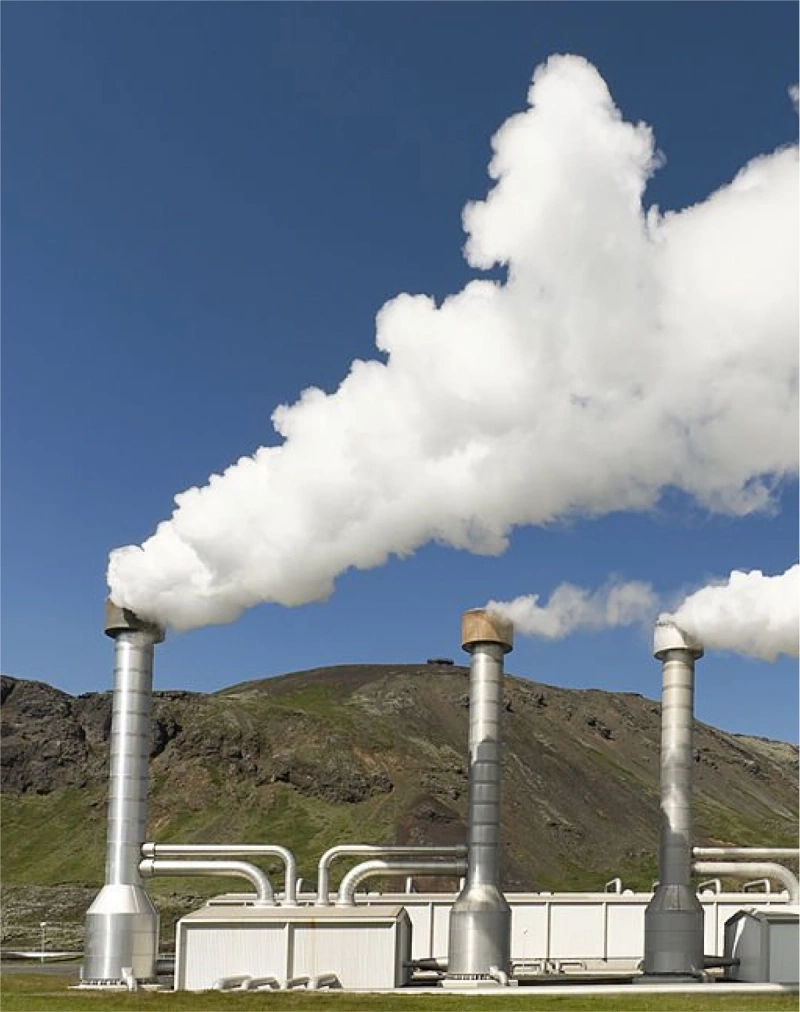
A geothermal power station in Iceland
But, on a practical level, both the United Kingdom and the European Union’s overall net-zero transitions require far more effective mechanisms to unlock investment.
In short, industry and investors need a business case: one supported both by demand for green products and services, and targeted interventions to stimulate investment. BE is supporting Europe’s journey to become a climate tech leader and meet its ambitious climate goals in a number of ways.
Cross-cutting
Low & Middle-
Income Nations
3
3
The key problem with getting the green premium on promising new technologies to zero is that initial production, with a new process and high learning curve, is often expensive, as evidenced by precedents like solar power and lithium batteries. So countries in a position to lower that either through procurement policies or tax credits, can send a helpful market signal for the rest of the world.

Wind turbines overlooking a rural road
Once we have the kind of better-performing alternatives incubated by organizations including Breakthrough Energy, our goal is to help roll out those products at scale — making them affordable enough to deploy in such large, middle-income countries as India and Brazil, and allowing millions, if not billions , of people to reduce emissions while still improving their quality of life. We rely on our evolving global network to make this happen, constantly expanding partnerships with philanthropic actors, lawmakers, advocates, and activists.
One common type of policy hurdle around the world is bureaucratic. For instance, emerging technologies in methane-reduced feed for cows have huge potential to decrease emissions.
But across countries with the biggest cattle inventory, it’s harder to get new kinds of food approved for animals than for humans, which makes it nearly impossible to scale these technologies. We are working globally to solve such policy obstacles, taking into account country-specific challenges and concerns at every step.
Breakthrough Energy Fellows
Fellows
1
1
Breakthrough Energy’s Fellows program has some similarities to well-known incubators like Y Combinator and TechStars, but there are key differences.
First, our program is focused on technology. The highly technical space we work in requires a highly sophisticated vetting and selection process. We do rigorous technical diligence up front, which also helps derisk technology down the line for our Fellows’ future investors.
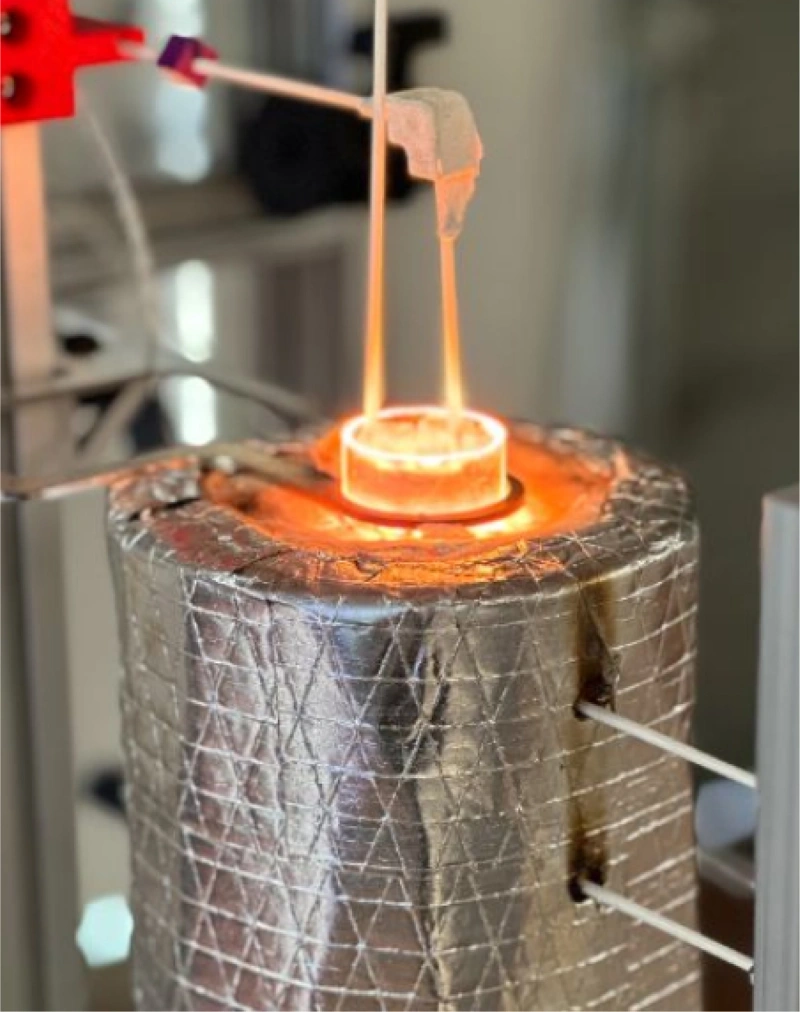
Furno's modular carbon-neutral cement kiln technology
Second, our Innovator Fellows — world-leading scientists and engineers with a critical climate technology to commercialize — work with a dedicated Breakthrough Energy management team that helps identify a specific set of technical milestones and checks in regularly on their progress, providing guidance and advisory support.
We also offer an unprecedented level of support for commercialization and growth through our Fellows business advisors program, which is unique in the field. These experienced industry leaders rotate from team to team, advising innovators one-on-one, on topics from fundraising and techno-economic modeling to navigating pilot opportunities and discovering customers.
Breakthrough Energy Fellows
Explorers
2
2
There are some ideas that are too early even for Innovator Fellowships: ideas that are not yet out of the lab, let alone spun out into a company.
That’s something we realized after Fellows' first year — which is why, during Cohort Two, we added the Explorer program . Explorers are working on research at universities that might lead to a company down the line. Their ideas are not just at an earlier stage, but often also carry higher technical risk than those of our full-time Fellows.

A biologist examining a plant in a greenhouse
Explorers are primarily academics. We enable them to spend a year at their home institutions, doing commercially-focused research that wouldn't get funded by traditional sources. An example of an Explorer is a plant biologist who has developed a way to decrease the emissions footprint of staple crops, and can see a path to commercialization. We guide them to work on a specific set of experiments, and to get the “technology readiness level” of their research as high as possible — like, for instance, expanding experiments from a model species to commodity crops like corn and soybeans.
If their experiments work, they’re ready for the next stage and have a pipeline to become Fellows. Some Explorers from last year have already joined us as Innovator Fellows in Cohort Three.
Breakthrough Energy Fellows
Workshops
3
3
The final, and newest, piece of our work at the discovery stage are workshops. These are intended for us to gain insight into the critical, but often overlooked areas of scientific discovery that could unlock some holy grail solutions. Our workshops bring together scientific experts on some of the most cutting-edge subfields, like high temperature superconductors and hydrogen storage applications, to identify, at the earliest possible stage, if there are ideas or concepts that we can eventually scale up to an Explorer or Fellows project, or even straight to a company that’s ready for investment.

An illustration of a superconductor
This September, we brought together experts, researchers, and startup founders to specifically discuss metal hydrides as a new hydrogen storage option. Why? Hydrogen is a prime energy carrier — a potential replacement for fossil fuels — but safely storing hydrogen at high efficiency and low cost remains a major challenge.
Metal hydrides are a unique potential solution. They can store hydrogen inside a solid-state material using only temperature and pressure. In addition, metal hydrides have potential applications for other energy systems such as heat pumps, cooling, thermal storage, and heat upgrading.
With that in mind, we asked questions to some of the field’s leading scientists like: What kind of applications are possible if they do work? What ancillary technology might we need to make that possible? What else should we be researching around this subject? Our hope is, no matter which of these theoretical technologies work out, or when, we’ll be in a good place to develop a commercial ecosystem around it.
Breakthrough Energy Catalyst
What We’ve
Achieved (So Far)
1
1
Catalyst has identified five areas that were ripe for our unique derisking approach: clean hydrogen, long duration energy storage (LDES), sustainable aviation fuel, direct air capture, and manufacturing.
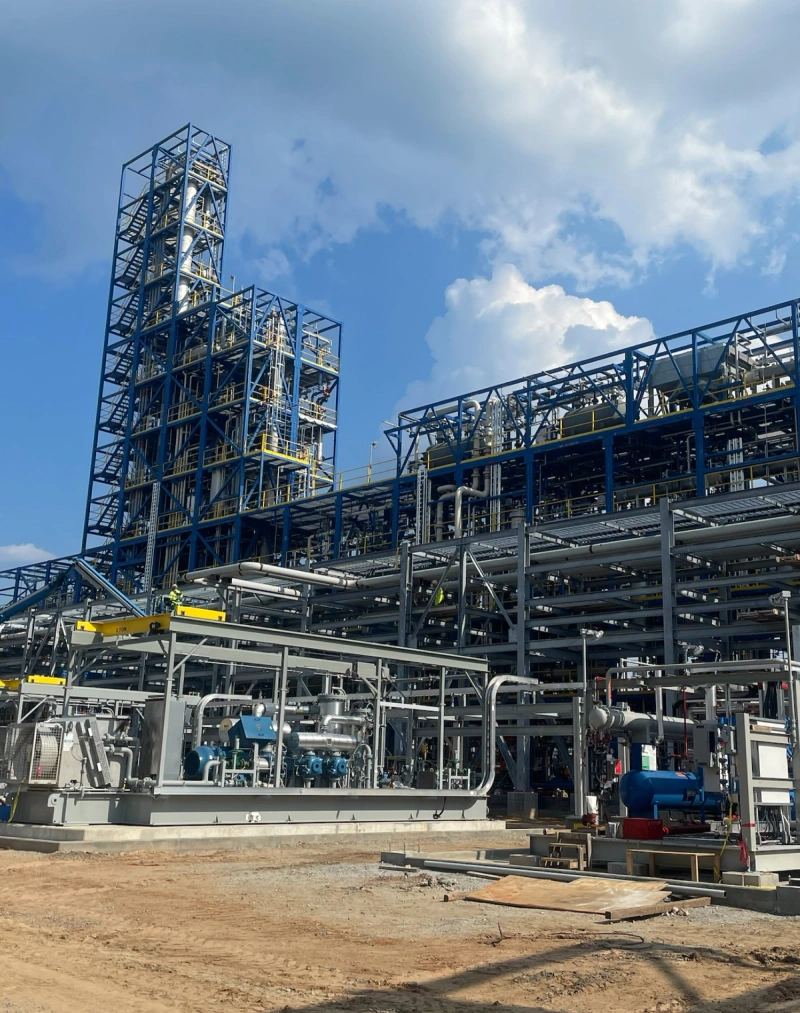
LanzaJet’s alcohol-to-jet biorefinery in Soperton, Georgia.
These are areas where new technologies have emerged from the discovery and development phases but are not yet mature enough to attract capital from typical infrastructure investors.
They’re also areas where the technologies are more expensive than fossil-fuel alternatives. Over the past year, the Catalyst team has tried to home in on technologies in these areas. We’re looking at ones that will reduce the most emissions and will be easily replicable. We’ve also attracted projects that are geographically diverse, with out one-third of our investments happening in Europe.
Breakthrough Energy Catalyst
What We’ve
Learned (So Far)
2
2
If there’s one thing we’ve learned over the last year, it’s that this is hard work. All of these technologies will face obstacles related to financing, technological reliability, standardization, and regulation. So how can they avoid the common pitfalls of scaling up? Here are five things the Catalyst team has learned so far.
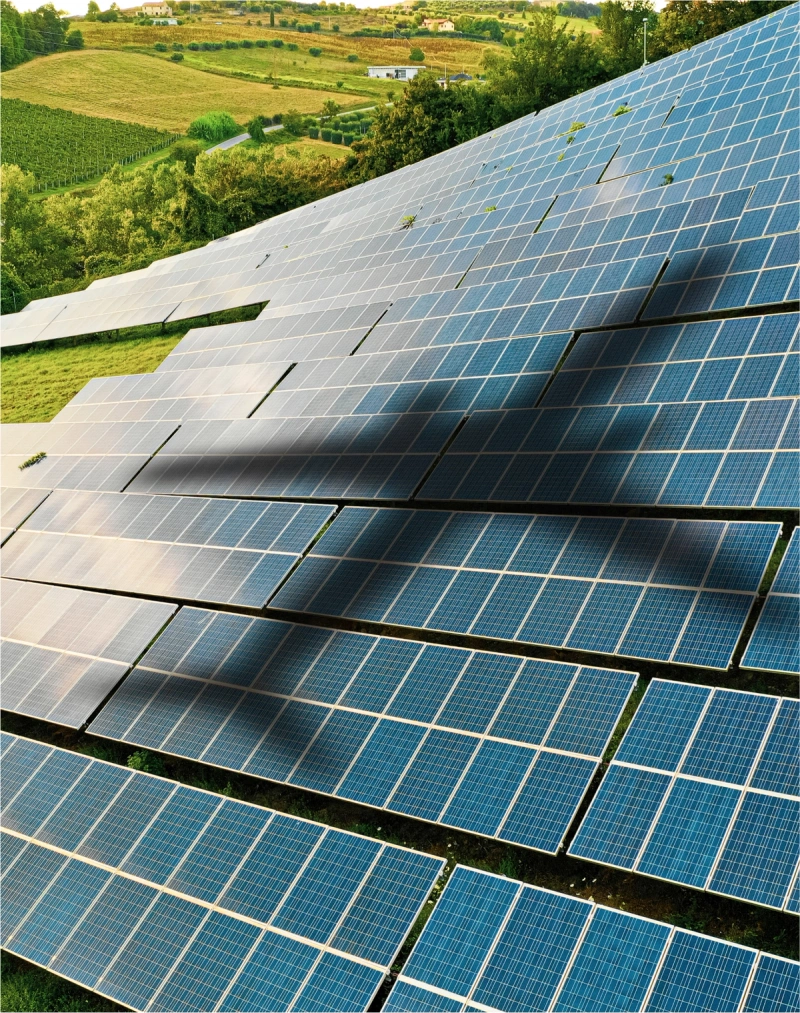
The shadow of a plane against an array of solar panels
First, these companies need a marketplace that sets them up for success. That means securing strategic anchor investors and long-term offtake agreements for their products under terms that will eventually attract infrastructure investors.
Take the airline industry, for example. We know we need to cut emissions from plane travel. One avenue is through sustainable aviation fuel (SAF). It is one of the most straightforward decarbonization stories given that, for the most part, infrastructure and airplanes do not need to be replaced —– just the fuel. Unfortunately, airlines typically only buy fuel stock for months at a time, not multiple years ahead. That is far too short of an offtake for emerging SAF companies to attract investment and guarantee revenue. It’s critical that aviation fuel buyers agree to offtake agreements of no less than ten years in order to give investors the confidence they need to invest capital in production. Catalyst has helped explain this to forward-thinking airlines, and those airlines are signing long-term agreements for some of the projects we are backing.
We’ve seen this work before. The solar and wind power revolutions were built on the backs of 20-year offtake agreements with utility companies. This gave investors the confidence to support these technologies, helping them scale and ultimately change the landscape of the electricity industry.
What’s Next
Expand, Expand,
Expand
3
3
As we head into the new year, Breakthrough Energy is focused on expansion across all areas of our deployment work. How do we expand funding to projects beyond our current pipeline of projects? How do we reach deeper into the decarbonization of industry? How do we expand our reach to support projects in other markets around the globe? How do we expand our partnership base and draw in new investors to help lift up these critical technologies?

Rows of pipeline at sunset
If we’re going to meet our climate goals, we need to catalyze innovation all around the world. With the right capital solutions and expertise, cleaner alternatives can displace carbon-intensive technologies and help us reach net zero.
Electrify
Everything
1
1
In the early 2000s, the public conversation around climate change often boiled down to a footprint. Conventional wisdom — and several handy calculators and quizzes — told us that we needed to reduce our carbon footprint by using less electricity.
They got the first part right. We do need to reduce our carbon footprint to net zero. But over the last decade, experts have developed a new, counterintuitive understanding of how to get there:

Major city lit up at night
We don’t sacrifice our use of electricity.
We expand it.
Here’s why: When you run your air conditioner or heat your oven, that usually burns carbon because most homes are connected to a power grid. At the other end of that grid is often a coal or natural gas plant.
Today, those plants account for about a quarter of all emissions globally. To get to net zero, the world needs to replace those carbon-emitting sources of energy with clean ones.
Renewables
The Winds —
and Rays —
of Change
2
2
Since Breakthrough Energy was founded eight years ago, the proliferation of wind and solar power has been astonishing.
Last year alone, the world deployed 280 gigawatts of renewables —about 23 times the electricity consumption of New York City. And as we’ve gotten more efficient at producing them, these sources have also become more affordable. Solar cells were 10 times cheaper in 2020 than in 2010.

An illustration of four offshore wind turbines
We’ve also seen growth and innovation in geothermal and hydropower. In fact, hydropower is the biggest source of renewable energy in the United States — and new technologies
are creating ways to access it in different circumstances than the traditional large-scale dams we're used to.
And if we can find a cost-effective way to tap into Earth’s vast reserves of deep geothermal heat, we have a huge opportunity to provide large amounts of zero-carbon power: experts estimate more than 1,000 gigawatts are readily available in the United States alone.
For example, Fervo
, a Breakthrough Energy Ventures company, uses new drilling technologies to drill horizontally
into geothermal reservoirs. Not only does this open up new, untapped reservoirs of power, but it also lowers our carbon footprint by allowing us to drill multiple wells from the same location.
But it’s still not enough — especially given the ongoing challenges, including that nearly half of the wells dug for geothermal power turn out to be duds.
Storage
Energy When
We Need It
3
3
Generally, when you make electricity from solar and wind power, you get it when they give it, unless you can store it for another time. That’s why storage — one of the biggest challenges the world faces in the energy transition — has been such a significant area of investment for Breakthrough Energy and innovators throughout climate tech. It’s central to building a clean and reliable grid. And it is key to fulfilling the promise of renewable energy — ensuring that it can be stored so that it’s available on demand.

Antora Energy's thermophotovoltaic cell
In the short term, the best way we have to store this electricity is through batteries. While this technology has improved in recent years, it is still incredibly expensive.
Researchers are continuing to work on ways to extend their duration and make them more cost effective. But some of the most exciting developments we’ve seen have come in long-duration energy storage (LDES) technologies.
Transmission
Energy Where
We Need It
4
4
So, we’ve discussed storing energy. But how do we move it?
Let’s use the United States as a case study. Last summer, the United States Congress passed the Inflation Reduction Act , investing billions in clean energy and taking a historic step towards building the economy needed to meet the goal of decarbonizing the power sector by 2035.

The flow of electricity
But there’s a problem: The United States’ power grid isn’t ready for it. Right now, the United States’ outdated power grid is creating a bottleneck effect—they have the energy, but it has nowhere to go.
Storage
Fission, Fusion,
and the Future
5
5
We need every tool at our disposal to fight climate change, because almost every energy source presents tradeoffs. We’ve talked about wind and solar, storage, geothermal, and hydropower — all critical technologies.
But we haven’t yet discussed the elephants in the room: nuclear fission and fusion.
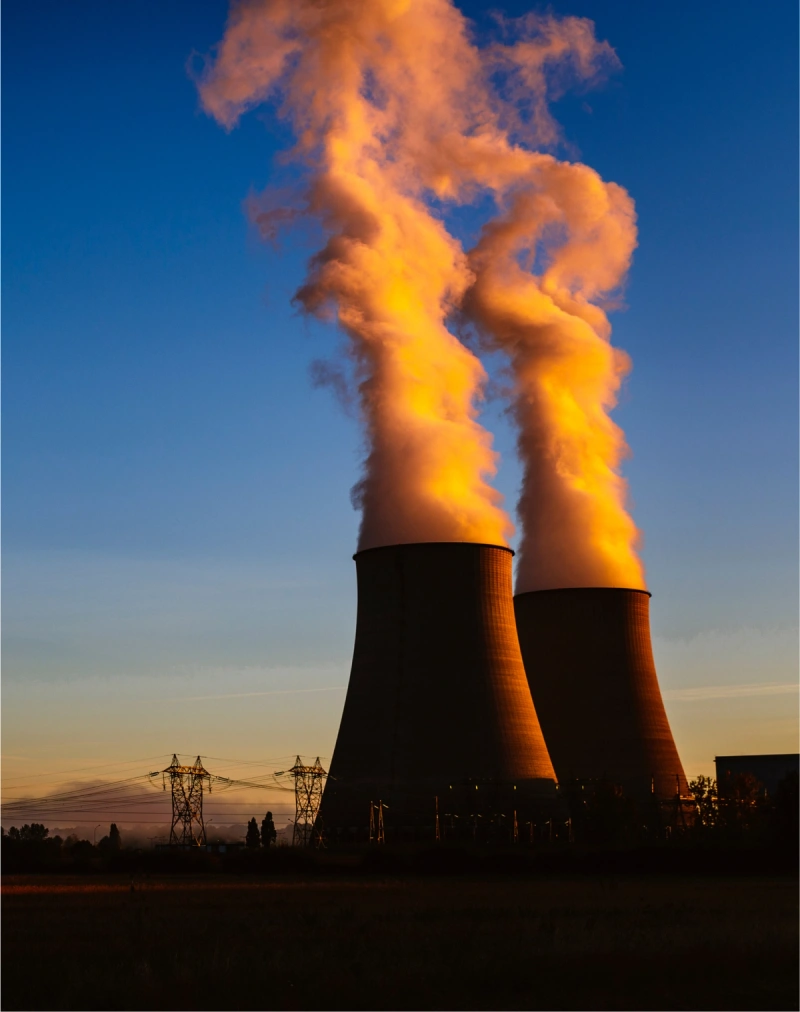
Smoke rising from a nuclear plant in France
Old Buildings,
New Ideas
1
1

An old brownstone in New York City
The median age of a building in New York City is 90 years old. In Europe, over 85% of today’s buildings will still be standing in 2050, and the majority were built before energy efficient standards existed. Point is, buildings last a long time.
The buildings our grandparents constructed are still emitting CO₂ today. And the ones we build today will likely keep emitting CO₂ long after we’re gone.
What’s more, the updates we make to buildings rarely make them more efficient. In Europe, for example, 10% of buildings are renovated every year. But only one percent of those renovations have a positive impact on the building’s energy usage.
This is a major climate challenge. Buildings account for seven percent of global emissions, and that’s just measuring on-site energy usage. Taken together with source energy (i.e. the total amount of raw fuel needed to operate buildings, including transmission, delivery, and production losses) and embodied carbon, they account for approximately 40% of global CO₂ emissions, which makes buildings the largest contributor of all the sectors we’ve discussed.
But since we’ve already covered the majority of embodied CO₂ emissions caused by using cement and steel in building construction, we’re going to focus this section on the carbon footprint of operating homes and buildings.
Through air conditioners, furnaces, and water heaters, heating and cooling today’s buildings consumes a lot of energy and emits a lot of CO₂ in the process. Buildings also waste much of the energy these devices produce. Our structures are essentially leaky containers, filled with single-pane windows and uninsulated, leaky ducts that let energy out. In fact, as much as 40% of heated or cooled air leaks out of the typical building.
Everything Under Control:
Raising a
Commercial
Building’s IQ
2
2

A green building facade
In 1999, Disney released an original film called Smart House about a futuristic home that develops a mind of its own, with controls for everything imaginable. Sentient homes that turn evil aren’t quite what we’re going for, but building automation is a key piece of the decarbonization puzzle. Because the better you can control a building’s energy usage, the better you can limit its emissions.
That’s the idea behind companies like 75F , which is working on advanced building controls for small-to-medium sized buildings that often get overlooked by automation advances. We know that building intelligence can have a major impact on efficiency.
We’ve already seen this progress in other areas of our lives. For example, when you get in a car these days, there’s a button, lever, or dial at your fingertips for just about everything: A/C, seat-heaters, defrost, music, GPS, gas levels. Buildings should be the same. There’s no reason a four-story condo building should have fewer controls than a two-passenger car.
Keeping Our Cool
Innovations for the Coming A/C Boom
3
3

Extreme heat is accelerating the A/C boom, creating a vicious emissions cycle
One of the most frustrating paradoxes of climate change is that, as the world gets hotter, our main method of cooling down could make climate change even worse.
Not only do air conditioners increase CO₂ emissions, they also leak an even more harmful substance: refrigerants. Known as F-gases, refrigerants cause thousands of times more warming than an equal amount of CO₂.
We have to break this vicious cycle, because the demand for cooling isn’t going anywhere but up. Global heating demand is nearly 30 petajoules per year. To put that in perspective, that represents more than 780,000 years worth of electricity for the average American home. But cooling is projected to surpass it before the end of the century.
More than 90% of American homes already have an air conditioner, compared to just 12% of homes in India. But as temperatures in already hot places like India continue to increase, more people will want access to air conditioning. By 2050, there will be more than five billion A/C units in operation around the world — more than twice the amount in use today. Air conditioners will consume as much electricity as all of China and India do now.
Some Like It Hot
Why Heat Pumps
Are Key to
Decarbonization
4
4
Even as temperatures rise, winter is still coming. And just as we’re exploring ways to cool down our homes without warming our planet, we also need clean and efficient ways to stay warm when things get frosty.
Today, furnaces and water heaters account for a third of all emissions that come from the world’s buildings. And unlike A/C units, they don’t all run on electricity. They’re typically powered by oil, natural gas, or propane, which means just cleaning up our electricity grid won’t solve the problem.
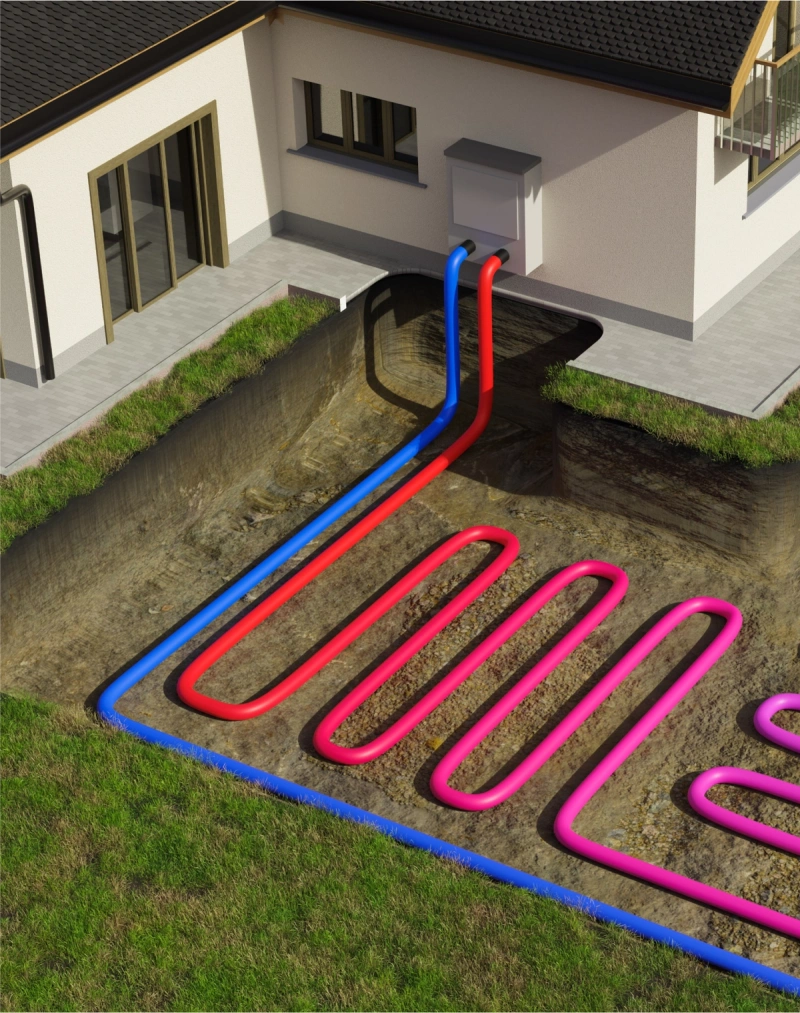
An illustration of a ground-source heat pump system using geothermal energy
That’s where heat pumps come in. Because heat pumps run on electricity, they move us away from needing fossil fuels to heat our homes.
There are many different heat pump designs, but the process is similar in all of them: transferring heat from your home to an outside source to cool it down, or transferring heat from the outside source into your home to heat it up. It’s the source that changes from design-to-design. For example, air-source heat pumps use the air outside your home. Air-water pumps use reservoirs of water with steady temperatures.
A company called Dandelion uses a powerful geothermal heat pump to replace your home’s entire HVAC system. This heat pump takes advantage of the stability of the Earth’s temperature ten feet underground, which remains 55 degrees Fahrenheit during both winter and summer. During the warmer months, the heat pump takes heat out of your home and puts it in the ground. Once winter rolls around, it takes heat from the ground and puts it back inside your house.
Window of Opportunity
Breaking Up with
Single-Pane Glass
5
5
Look out your window and you’ll see another way your house may not be as efficient as it should be. No, we’re not talking about what you see from the window. We’re talking about the window itself.

An open window looking out at the countryside on a foggy day
The window glass in most of the world’s homes and buildings is single-pane, which means a lot of the heat from your house is leaking out, forcing your HVAC system to work harder, cost you more money, and emit more CO₂ into the atmosphere.
In fact, windows are the number one source of heat gain in the summer and heat loss in the winter.
Duct, Duct, Loose
Sealing
Your Home
6
6

A one-story home
Another way your home is losing energy is through what developers call a “leaky envelope.” In addition to windows, your home often has loose ducts and cracks in the walls that allow air to leak out.
Plugging these leaks can help lower energy usage and save you money on your next energy bill.
Aeroseal is shrinking carbon emissions from residential and commercial buildings
Steel and Cement
The Hardest Decarbonization Challenge (Pun Intended)
1
1
So far, this report has avoided rank-ordering our carbon problems — because that’s pretty much impossible. What’s harder to decarbonize: the world’s electricity grid or our transportation sector? Or what about our food supply? There’s no real consensus, with one salient exception: manufacturing.
That shouldn’t scare us off, though. If anything, it should motivate us. Because in the face of the toughest challenge, we’ve already started making inroads.

A worker at a steel plant
Today, 29% of all GHG emissions come from how we make things
.
And this may be the most difficult chunk of carbon to get rid of.
Why? Because of the two most commonly manufactured materials on Earth: steel and cement . (How common are we talking? Concrete, the mixture of cement and water, is the second-most consumed material on the planet, after water.)
Concrete Jungle
Reinventing
Cement
2
2

A cement mixing truck
Today, the global cement market is worth nearly $900 billion. About 60% of cement emissions come from the “process,” whereby carbon dioxide is released from limestone to form calcium oxide. The other 40% come from energy, or the heat that makes things like mining and limestone processing possible.
It’s hard to displace cement, because most alternatives, like clay bricks, have higher emissions per unit, cost more, or don't have the same broad functionality.
So how should we think about decarbonizing cement?
A New Look
Green
Steel
3
3

A steel furnace
3000 years after we started making steel, this strong and cheap alloy of iron and carbon represents over 90% of all the metal used in the world. It’s also the single most emissive manufactured good on earth — responsible for roughly 2.5 gigatons of carbon dioxide (CO₂) emissions each year, excluding the emissions from generating electricity used in steel production (those are included in the electricity section).
That’s about five percent of all global greenhouse gas (GHG) emissions.
Carbon isn’t just a source of energy in steelmaking, but also the most common reducing agent that helps rip the oxygen off naturally-occurring iron ore to make steel. 70% of today’s steel is made in blast furnaces, a technology invented in the 18th century to reduce steel using huge quantities of carbon.
Decarbonizing steel is hard, due to the metal’s extremely broad functionality, but we do have two broad paths to try and do so. The first is by decarbonizing the primary steelmaking process itself, and the second is by increasing the quality and quantity of recycled secondary steel.
Beyond Innovation
Policy & Consumer Choice
4
4
These are all incredible, cutting-edge technologies, many of which were unimaginable just a decade ago. But technology isn’t the whole story.
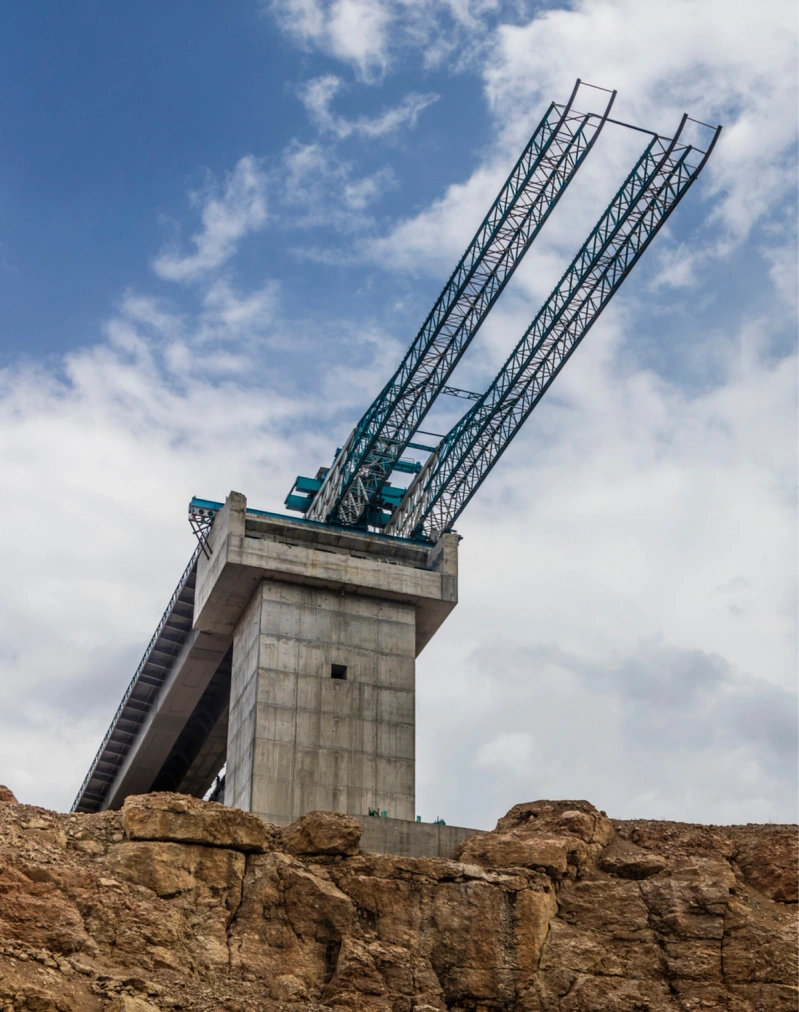
Bridge under construction
Imagine, for instance, that you’re a contractor. You’re putting in your proposal for a new bridge that has to be built. What do you choose? A design that uses the normal recipe for cement that you’ve used your entire career — the formula that local building regulations say is approved?
Or do you propose using a different kind of carbon-free cement that, while just as strong, isn’t specifically approved by the government, meaning if something breaks, it’s on you?
Battery Fires and Rare Metals
The Remaining
Roadblocks for
Electric Vehicles
1
1
Electric vehicle EVs adoption is still in its infancy, but like an infant, it’s expected to grow fast: according to a recent report by Bloomberg New Energy Finance, electric vehicles could be 75% of all global passenger vehicle sales by 2040.

Aerial view of the Skouriotissa copper mine in Cyprus
Over the past decade, auto and policymakers have taken a jackhammer to the roadblocks that previously stood in the way of mass EV adoption. Some EVs, today, are nearly as cheap as their internal combustion engine counterparts. With one battery charge, they can travel about as far as a traditional vehicle does on a tank of gas.
And when the battery is low, there are thousands more places to plug in. In the United States, the number of charging stations nearly doubled between 2019 and 2022, and the Inflation Reduction Act could triple the current number, adding an estimated 500,000 EV chargers by 2030. We still have a ways to go to make EV charging as widespread, seamless and fast as filling up a gas tank, but our progress is undeniable.
And yet, as these roadblocks have started to crumble, two new ones have appeared.
Charge declined!
Why batteries won’t work for planes, ships, and trucks at long distances — and what to do about it
2
2
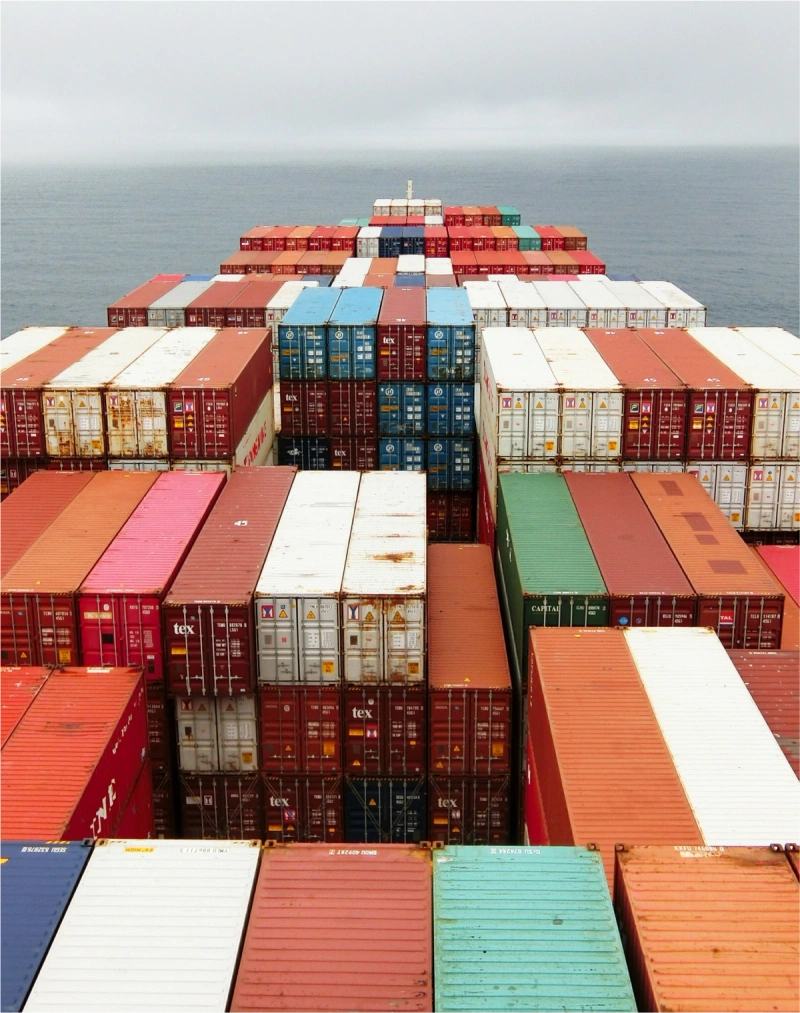
Shipping containers at a port
Of the five “grand challenges” discussed in this report, transportation is the only one where people have to lug their energy around with them. The problem is that — as far as power sources go — it’s hard to find something better to lug than gasoline. It’s shelf stable, cheap, and energy dense.
Fleetzero is working to decarbonize cargo shipping
Per gallon, gas costs about as much as bottled water and packs more energy than a stick of dynamite. The best lithium-ion batteries, by comparison, contain 35 times less energy pound-for-pound, meaning that to get the same amount of energy as a gallon of gas, you’ll need batteries weighing 35 times heavier.
Holy Cow
Tackling Livestock Emissions
2
2
During the COVID-19 pandemic, the race for a vaccine consumed our world. Scientists and innovators put their heads together to find, test, scale, and mass deploy mRNA vaccines to the globe’s nearly eight billion people, one of the greatest feats of ingenuity in human history.

A portrait shot of a cow
What if we told you there could be a "vaccine" for climate change? Well, at least for a big part of it. Let’s explain.
We know burping is impolite. But when it comes from cows, it also imperils our planet. That’s because cows digest food differently than humans do.
Feritilize This
Sustainable Crop Production
3
3
Meat isn’t the only farming activity contributing to or being impacted by climate change. After livestock, deforestation and land-use change account for the largest source of agricultural emissions.

An aerial view of croplands
Feeding the world is a tall order, and climate change has only made things harder. At our current crop yield rates, we will need an additional 500 million acres of cropland — the size of Argentina — by 2050 to meet rising demand for food. That’s going to be a huge driver of deforestation and, in turn, emissions
To address these challenges, we must seek innovative solutions that reduce emissions, increase crop yields, enhance resource efficiency, and build climate resilience.
The best way to reduce deforestation while still meeting rising food demand is to improve the amount of food we produce per acre. That starts with tackling the emissions and inefficiencies of the most important product farmers use to grow their crops: synthetic fertilizer.
The Taking Tree
Nature-Based Carbon Removal
1
1
There are several natural ways to remove CO₂, from planting trees and preventing deforestation to managing soil more efficiently and seeding algal blooms with iron. Currently, these methods remove about 30% of annual emissions. They’re relatively inexpensive, globally scalable, and have added co-benefits like increased crop yields.

Aerial view of a forest damaged by fire
But nature-based removal has some challenges. For starters, it’s not permanent. Forests and croplands are prone to wildfires and other natural disasters, which would quite literally send all the carbon they trap up in smoke and back into the atmosphere.
Nature-based removal is also hard to measure. How do we know that what is happening is actually additive? Would a tree have grown naturally in a similar spot even without sending someone to do it? What’s to stop people from taking money in exchange for protecting forests in their area that they were never planning to cut down in the first place?
Direct Air Capture
Engineered Carbon Removal
2
2
The concept of engineered direct air capture (DAC) is simple: We take carbon directly from the air and store it safely underground permanently. No risk of wildfires or tornadoes coming along and reversing all of our progress. And unlike nature-based removal, the benefits of DAC are highly quantifiable; in other words, we know exactly how much CO₂ we’re pulling out of the air.
It’s also permanent. Once we inject CO₂ into things like concrete or underground reservoirs, it stays there. Or in climate terminology, it’s “durable.”
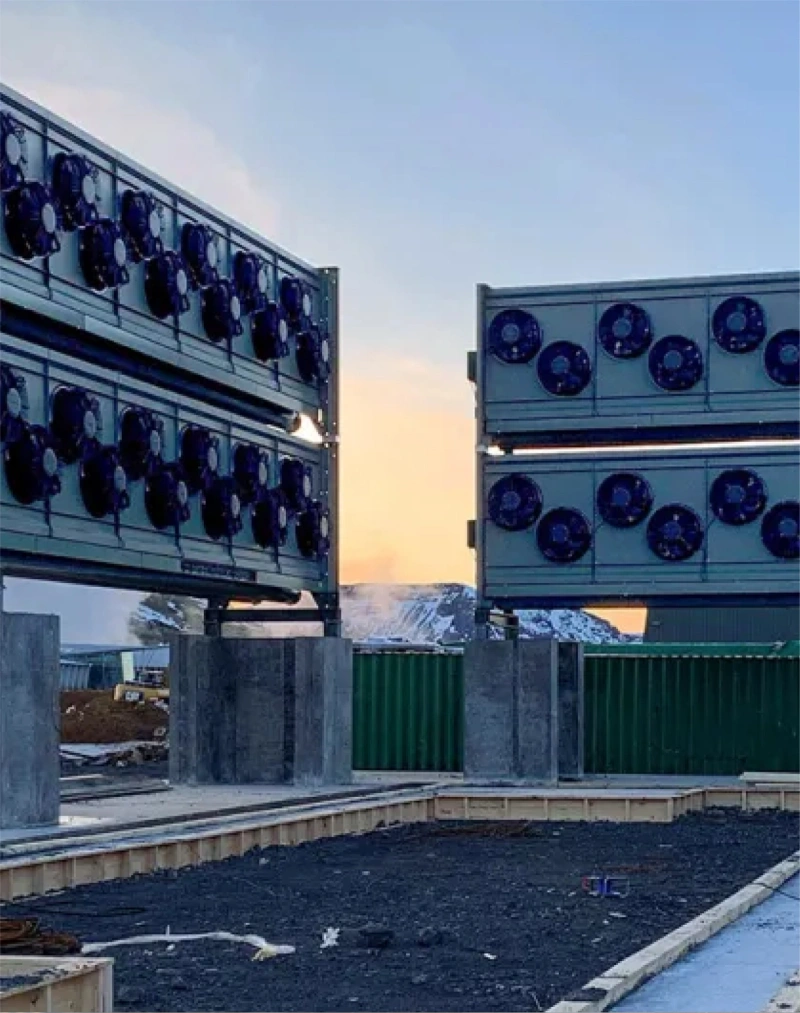
Climeworks’ DAC+S facility “Orca” in Iceland
So what’s the problem? Well, there are a few. DAC isn’t cheap.
In fact, it’s some of the most expensive technology out there, coming in at above $1,000 per ton of CO₂ for individual buyers and more than $750 per ton for corporate or bulk buyers. That’s partly why at the moment, there are only two commercial-scale facilities in operation in the world, one in Iceland and run by a company called Climeworks (which is not part of the BEV portfolio) and another that was just opened by Heirloom in November 2023. But like point-source capture, no matter how much the cost of direct air capture comes down, it will always cost more than doing nothing. Without policy intervention, there is little incentive for companies to pursue it.
DAC is also highly energy intensive. And no nation wants to take precious clean electrons to remove carbon instead of providing power to its people and businesses.
Then there are the legal issues. To put things in the ground, you need to go through siting, permitting, and other regulatory hurdles that can take years.
The Hybrid Way
Carbon Casting
3
3
There is a third option, a hybrid of the first two we’ve discussed that combines the strength of nature-based approaches with the lasting impact of engineered removal.
Graphyte is one company exploring this area. Incubated by Breakthrough Energy Ventures, Graphyte has developed a carbon dioxide removal approach that is permanent, affordable, and immediately scalable.

Inert carbon blocks created by Graphyte to store biomass.
Foresters and farmers already capture billions of tons of CO₂ each year in the form of timber and crop residues that are left to decompose into CO₂ and methane. But what if carbon-rich biomass can be transformed into permanently sequestered carbon?
That’s what Graphyte does with its Carbon Casting technology. This process dries the biomass to remove microbes and the water they depend on, then creates inert carbon blocks protected by an impermeable barrier to ensure the biomass decomposition does not restart. These blocks are stored in monitored, underground storage sites that provide a further layer of protection and enable robust long-term monitoring.
This new technology provides an immediate pathway to low-cost carbon removal with durability over 1,000 years. Combining photosynthesis with practical engineering enables Graphyte to meet long-term cost targets in the near term, whereas other approaches hold the promise of achieving these targets over many years, contingent on future innovations.
Policy and Persuasion
4
4
Innovation is key, but we can’t scale these technologies without proactive policy. This past summer, the United States saw a major breakthrough on that front when the Department of Energy announced its first round of Direct Air Capture hubs awards, the single largest investment in the history of DAC. These hubs can bring together multiple DAC companies within the same facility to access shared infrastructure so they can scale their technology faster and do it at a lower cost.

A visualization of a rural direct air capture facility
Policy isn’t the only tool in our arsenal. We also need to increase understanding about these technologies. For example, direct air capture remains relatively unknown among the public. But when people understand it better it gains support, especially when they learn about its potential to create jobs and address emissions.
Again, carbon removal shouldn’t be an excuse to keep emitting. We must continue our efforts to decarbonize every sector of the global economy. In other words, we still need to turn off the spigot, even if we can drain some of it.
But the bottom line is, carbon management needs to be an option that remains on the table. Despite its drawbacks, it’s a vital tool for the future. And no one’s ever solved a problem faster with fewer tools at their disposal.
